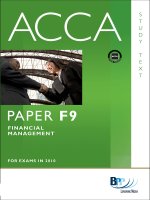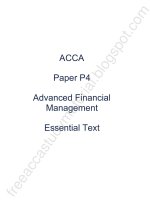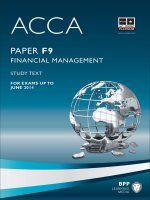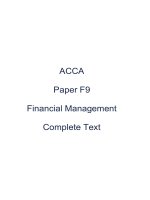Paper F7: Financial Management - Study text 2016
Bạn đang xem bản rút gọn của tài liệu. Xem và tải ngay bản đầy đủ của tài liệu tại đây (7.81 MB, 530 trang )
APPROVED
CONTENT PROVIDER
ACCA Approved
Study Text
Paper F9
Financial Management
Study Text for exams from
1 September 2015 to 31 August 2016
Free access
to our Exam
Success site
Look inside
/>
/>ACCA APPROVED CONTENT PROVIDER
As the irst accredited publisher of ACCA materials, BPP Learning Media has set the benchmark for
producing exceptional study materials for students and tutors alike.
Our Study Texts, Practice & Revision Kits and i-Passes (for ACCA F1/FIA FAB, ACCA F2/FIA FMA, ACCA F3/
FIA FFA and ACCA F4) are reviewed by the ACCA examining team and are written by our in-house authors
with industry and teaching experience who understand what is required for exam success.
EXAM SUCCESS SITE
To help maximise your chances of succeeding in your exams, we’ve put together a suite of exclusive ACCA
resources. Our Exam Success site provides you with access to a free digital version of this publication, as
well as extra resources designed to focus your efforts on exams and study methods.
To access the Exam Success site, please email with the subject line “Access to Exam
Success site - eBook”, including your order reference number and the name of the book you’ve bought (ie
ACCA F7 Study Text) for your access code. Once you have received your code, please follow the instructions
below:
To access the BPP ACCA Exam Success site for this material
please go to:
www.bpp.com/ExamSuccessSite
n Create a user account if you don’t already have one.
Make sure you reply to the conirmation email.
n Log in using your registered username and password.
Select the paper you wish to access.
n Enter the code you received when prompted. You will only
have to do this once for each paper you are studying.
/>
/>
S
T
U
D
Y
T
E
X
T
PAPER F9
FINANCIAL MANAGEMENT
BPP Learning Media is an ACCA Approved Content Provider. This means we work
closely with ACCA to ensure this Study Text contains the information you need to pass
your exam.
In this Study Text, which has been reviewed by the ACCA examination team, we:
the
how each chapter links to the syllabus and the study guide
in the syllabus and the
lots of
you need
demonstrating what is expected of you in the exam
in regular
in
in our
in our
BPP's Practice & Revision Kit products also support this paper.
/>
/>
First edition 2007
Eighth edition April 2015
ISBN 9781 4727 2678 0
(Previous ISBN 9781 4727 1084 0)
e-ISBN 9781 4727 2756 5
A catalogue record for this book
is available from the British Library
All rights reserved. No part of this publication may be
reproduced, stored in a retrieval system or transmitted, in
any form or by any means, electronic, mechanical,
photocopying, recording or otherwise, without the prior
written permission of BPP Learning Media Ltd.
We are grateful to the Association of Chartered Certified
Accountants for permission to reproduce past
examination questions. The suggested solutions in the
practice answer bank have been prepared by BPP
Learning Media Ltd, unless otherwise stated.
BPP Learning Media Ltd
BPP House, Aldine Place
London W12 8AA
www.bpp.com/learningmedia
RICOH UK Limited
Unit 2
Wells Place
Merstham
RH1 3LG
Your learning materials, published by BPP Learning
Media Ltd, are printed on paper obtained from
traceable sustainable sources.
©
BPP Learning Media Ltd
2015
ii
/>
/>
Contents
Page
Introduction
Helping you to pass
Studying F9
The exam paper and exam formulae
Syllabus and study guide
v
vii
ix
xi
Part A Financial management function
1
Financial management and financial objectives
3
Part B Financial management environment
2
3
The economic environment for business
Financial markets, money markets and institutions
37
57
Part C Working capital management
4
5
6
Working capital
Managing working capital
Working capital finance
79
93
119
Part D Investment appraisal
7
8
9
10
11
Investment decisions
Investment appraisal using DCF methods
Allowing for inflation and taxation
Project appraisal and risk
Specific investment decisions
143
159
177
189
205
Part E Business finance
12
13
14
15
16
Sources of finance
Dividend policy
Gearing and capital structure
The cost of capital
Capital structure
225
259
269
291
317
Part F Business valuations
17
18
Business valuations
Market efficiency
337
361
Part G Risk management
19
20
Foreign currency risk
Interest rate risk
373
401
Mathematical tables
415
Practice question bank
Practice answer bank
Index
419
441
481
Review form
/>
Contents
iii
/>A note about copyright
Dear Customer
What does the little © mean and why does it matter?
Your market-leading BPP books, course materials and e-learning materials do not write and update
themselves. People write them: on their own behalf or as employees of an organisation that invests in this
activity. Copyright law protects their livelihoods. It does so by creating rights over the use of the content.
Breach of copyright is a form of theft – as well being a criminal offence in some jurisdictions, it is
potentially a serious breach of professional ethics.
With current technology, things might seem a bit hazy but, basically, without the express permission of
BPP Learning Media:
Photocopying our materials is a breach of copyright
Scanning, ripcasting or conversion of our digital materials into different file formats, uploading
them to Facebook or emailing them to your friends is a breach of copyright
You can, of course, sell your books, in the form in which you have bought them – once you have finished
with them. (Is this fair to your fellow students? We update for a reason.) But the e-products are sold on a
single user licence basis: we do not supply 'unlock' codes to people who have bought them secondhand.
And what about outside the UK? BPP Learning Media strives to make our materials available at prices
students can afford by local printing arrangements, pricing policies and partnerships which are clearly
listed on our website. A tiny minority ignore this and indulge in criminal activity by illegally photocopying
our material or supporting organisations that do. If they act illegally and unethically in one area, can you
really trust them?
iv
Introduction
/>
/>Helping you to pass
BPP Learning Media – Approved Content Provider
As ACCA's Approved Content Provider, BPP Learning Media gives you the opportunity to use study
materials reviewed by the ACCA examination team. By incorporating the examination team's comments
and suggestions regarding the depth and breadth of syllabus coverage, the BPP Learning Media Study
Text provides excellent, ACCA-approved support for your studies.
The PER alert
Before you can qualify as an ACCA member, you not only have to pass all your exams but also fulfil a three
year practical experience requirement (PER). To help you to recognise areas of the syllabus that you
might be able to apply in the workplace to achieve different performance objectives, we have introduced
the 'PER alert' feature. You will find this feature throughout the Study Text to remind you that what you
are learning to pass your ACCA exams is equally useful to the fulfilment of the PER requirement.
Your achievement of the PER should now be recorded in your online My Experience record.
Tackling studying
Studying can be a daunting prospect, particularly when you have lots of other commitments. The different
features of the Text, the purposes of which are explained fully on the Chapter features page, will help you
whilst studying and improve your chances of exam success.
Developing exam awareness
Our Texts are completely focused on helping you pass your exam.
Our advice on Studying F9 outlines the content of the paper, the necessary skills you are expected to be
able to demonstrate and any brought forward knowledge you are expected to have.
Exam focus points are included within the chapters to highlight when and how specific topics were
examined, or how they might be examined in the future.
Using the Syllabus and Study Guide
You can find the syllabus and Study Guide on pages xi–xxi of this Study Text.
Testing what you can do
Testing yourself helps you develop the skills you need to pass the exam and also confirms that you can
recall what you have learnt.
We include Questions – lots of them – both within chapters and in the Practice Question Bank, as well as
Quick Quizzes at the end of each chapter to test your knowledge of the chapter content.
/>
Introduction
v
/>Chapter features
Each chapter contains a number of helpful features to guide you through each topic.
Topic list
Topic list
Syllabus reference
What you will be studying in this chapter and the relevant
section numbers, together with ACCA syllabus references.
Introduction
Puts the chapter content in the context of the syllabus as
a whole.
Study Guide
Links the chapter content with ACCA guidance.
Exam Guide
Highlights how examinable the chapter content is likely to
be and the ways in which it could be examined.
Knowledge brought forward from earlier studies
What you are assumed to know from previous
studies/exams.
FAST FORWARD
Summarises the content of main chapter headings,
allowing you to preview and review each section easily.
Examples
Demonstrate how to apply key knowledge and
techniques.
Key terms
Definitions of important concepts that can often earn you
easy marks in exams.
Exam focus points
When and how specific topics were examined, or how
they may be examined in the future.
Formula to learn
Formulae that are not given in the exam but which have to
be learnt.
Gives you a useful indication of syllabus areas that
closely relate to performance objectives in your Practical
Experience Requirement (PER).
Question
Gives you essential practice of techniques covered in the
chapter.
Case Study
Real world examples of theories and techniques.
Chapter Roundup
A full list of the Fast Forwards included in the chapter,
providing an easy source of review.
Quick Quiz
A quick test of your knowledge of the main topics in the
chapter.
Practice Question Bank
Found at the back of the Study Text with more
comprehensive chapter questions. Cross referenced for
easy navigation.
vi
Introduction
/>
/>Studying F9
This paper examines a wide range of financial management topics, many of which will be completely new
to you. You will need to be competent at a range of quite tricky calculations as well as being able to
explain and discuss financial management techniques and issues.
The F9 examination team
The ACCA examination team expects you to be able to perform and comment on calculations, exercise
critical abilities, clearly demonstrate understanding of the syllabus and use question information.
Syllabus update
The F9 syllabus has been updated for the September 2015 sitting onwards. The syllabus changes are
summarised below.
Summary of changes to F9
The wording of syllabus areas B3(a)(i) and D4(b) has been amended. Syllabus area E5(d) has been
amended and now includes supply chain financing and crowdfunding as sources of finance.
/>
Introduction
vii
/>1 What F9 is about
The aim of this syllabus is to develop the knowledge and skills expected of a finance manager in relation to
investment, financing and dividend policy decisions.
F9 is a middle level paper in the ACCA qualification structure. There are some links to material you have
covered in F2, particularly short-term decision-making techniques. The paper with a direct link following
F9 is P4 which thinks strategically and considers wider environmental factors. F9 requires you to be able
to apply techniques and think about their impact on the organisation.
2 What skills are required?
You are expected to have a core of management accounting knowledge from Paper F2.
You will be required to carry out calculations, with clear workings and a logical structure.
You will be required to interpret data.
You will be required to explain management accounting techniques and discuss whether they are
appropriate for a particular organisation.
You must be able to apply your skills in a practical context.
3 How to improve your chances of passing
There is no choice in this paper; all questions have to be answered. You must therefore study the
entire syllabus; there are no shortcuts.
The first section of the paper consists of 20 multiple choice questions, worth two marks each.
These will inevitably cover a wide range of the syllabus.
Practising questions under timed conditions is essential. BPP's Practice & Revision Kit contains 2
mark, 10 mark and 15 mark questions to help you practise this.
Questions will be based on simple scenarios and answers to Section B questions must be focused
and specific to the organisation.
Answer plans in Section B will help you to focus on the requirements of the question and enable
you to manage your time effectively.
Answer all parts of the questions in Section B. Even if you cannot do all of the calculation
elements, you will still be able to gain marks in the discussion parts.
Make sure your answers focus on practical applications of management accounting, common
sense is essential!
Keep an eye out for articles, as the examination team will use Student Accountant to
communicate with students.
Read journals etc to pick up on ways in which real organisations apply management accounting
and think about your own organisation if that is relevant.
4 Brought forward knowledge
You will need to have a good working knowledge of certain management accounting techniques from F2.
In particular, you will need to be familiar with the capital budgeting process, and be able to apply the
concepts of interest and discounting. This includes being able to calculate annuities and perpetuities, and
to use the discount and annuity tables to calculate net present values.
This Study Text revises these topics and brought forward knowledge is identified. If you struggle with the
examples and questions used, you must go back and revisit your previous work. The ACCA examination
team will assume you know this material and it may form part of an exam question.
viii
Introduction
/>
/>The exam paper and exam formulae
Format of the paper
The exam is a three-hour paper divided into two sections. Section A consists of 20 multiple choice
questions of two marks each. These questions can be on any part of the syllabus.
Section B consists of three questions of 10 marks each and two questions of 15 marks each. The 10-mark
questions can be on any part of the syllabus. The 15-mark questions will cover two of Parts C, D and E of
the syllabus. All questions are compulsory. In Section B, answers to the questions will require a mixture of
calculations and discussion.
You also have 15 minutes for reading and planning.
The exam will cover as much of the syllabus as possible.
Exam formulae
Set out below are the formulae you will be given in the exam. If you are not sure what the symbols
mean, or how the formulae are used, you should refer to the appropriate chapter in this Study Text.
Chapter in
Study Text
Economic order quantity
=
5
2C0D
Ch
Miller-Orr Model
Return point = Lower limit + (
6
1
spread)
3
1
3
3
4 transaction cos t variance of cash flows
Spread = 3
int erest rate
The Capital Asset Pricing Model
15
E(ri) = Rf + ßi(E (rm) – Rf)
The asset beta formula
16
Vd (1 T)
Ve
e +
d
ßa =
(Ve Vd (1 T)) (Ve Vd (1 T))
The Growth Model
P0 =
15
D0 (1 g)
(re g)
Gordon's growth approximation
15
g = bre
/>
Introduction
ix
/>The weighted average cost of capital
15
V
V
WACC = e ke + d kd (1–T)
Ve Vd
Ve Vd
The Fisher formula
9
(1 + i) = (1 + r)(1 + h)
Purchasing power parity and interest rate parity
S1 = S0
(1 hc )
(1 hb )
F0 = S0
(1 ic )
(1 ib )
x
Introduction
/>
19
/>Syllabus and Study Guide
The F9 syllabus and Study Guide can be found below.
/>
Introduction
xi
/>
xii
Introduction
/>
/>
/>
Introduction
xiii
/>
xiv
Introduction
/>
/>
/>
Introduction
xv
/>
xvi
Introduction
/>
/>
/>
Introduction
xvii
/>
xviii
Introduction
/>
/>
/>
Introduction
xix
/>
xx
Introduction
/>
/>
/>
Introduction
xxi
/>
xxii
Introduction
/>
/>
P
A
R
T
A
Financial management function
/>
1









